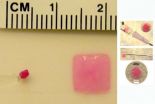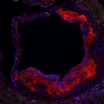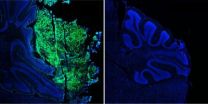(Press-News.org) With grilled chicken, salads and oatmeal now on fast food menus, you might think fast food has become healthier. And indeed, there has been greater attention in the media and legislatively, paid to the healthfulness of fast food. But a close look at the industry has found that calorie counts have changed little, while the number of food items has doubled.
A study led by Katherine W. Bauer, assistant professor in Temple University's Department of Public Health and Center for Obesity Research and Education, found that the average calorie content of foods offered by eight of the major U.S. fast food restaurants changed very little between 1997 and 2010.
In the study, published in the November issue of the American Journal of Preventive Medicine, researchers analyzed menu offerings and nutrient composition information from leading fast food restaurant chains in the U.S. using archival versions of the University of Minnesota Nutrition Coordinating Center's Food and Nutrient Database. McDonald's, Burger King, Wendy's, Taco Bell, KFC, Arby's, Jack in the Box and Dairy Queen were chosen because they had been in the database since 1997, each has defined set of offerings on the menu and all standard menu items are included in the database.
One striking finding was a 53 percent increase in the total number of offerings — 679 to 1036 items — over 14 years across the restaurants. Specific fast-growing additions to the menus include the number of entree salads, which increased from 11 to 51, and sweetened teas, which went from zero to 35.
The study authors did not find any large changes in the median calorie content of entrees and drinks. A gradual increase in calories was found in condiments and desserts. Meanwhile, a decrease in the median calories of side items was observed — from 264 to 219 — which may be due to the addition of lower-calorie side salads and some restaurants limiting the portion sizes of side items like French fries.
Bauer notes that very high calorie items have been added to menus at the same time as the lower-calorie items, and it may be difficult for an average consumer to sort through these rapidly expanding fast food menus.
In the last years examined, 2009 and 2010, lunch and dinner entrees had 453 calories on average per item while side items had 263 calories on average.
"You might order a lower-calorie entree, but then you get a drink, fries and a dessert," said Bauer. "Calories can add up very quickly. A salad can be low calorie, but not when it includes fried chicken and ranch dressing. Sweetened teas are just empty calories."
Eating fast food becomes a concern when someone eats too much of it too often. Studies have consistently found associations between fast food intake and excess weight and weight gain among adults. A recent survey of adults found that 80 percent purchased fast food in the past month and 28 percent consumed it two or more times a week. On a typical day, nearly 40 percent of teens consume fast food.
"We're not saying you shouldn't ever eat fast food, but you need to think about things like portion size, preparation method, condiments and the total caloric content of your meal," said Bauer.
In the near future, consumers will be able to see calories for all food items posted at restaurants and food vendors with more than 20 locations, as mandated by the Patient Protection and Affordable Care Act of 2010. McDonalds recently began posting calories on its menus.
"Using this study as a start, we'll be able to see if being required to post the calorie content of menu items — the primary aim of which is to inform consumers — prompts any changes by the fast food industry," said Bauer. "While some localities such as Philadelphia and New York City already require menu labeling, when the effort is rolled out nation-wide fast food restaurants may modify the calorie content of the foods they sell so consumers can see a smaller number on the menu board.
"Without massive changes by the fast food industry in the caloric content of food, the key is for consumers to try to educate themselves about calories and be aware that just because a restaurant promotes healthful options, does not mean that overall the foods sold are lower calorie," she said. "Over time, with increased exposure to calorie information on menus, people may start to understand how many calories they should consume each day."
###
Co-authors of the study are Mary O. Hearst, of St. Catherine University; and Alicia A. Earnest, Simone A. French, J. Michael Oakes and Lisa J. Harnack, of the University of Minnesota School of Public Health's Division of Epidemiology and Community Health. The study was funded by the Robert Wood Johnson Foundation through the Healthy Eating Research program and by the National Institutes of Health.
Fast food menu options double; calorie counts remain high
Study finds media scrutiny and legislative pressures have not led to fast food calorie reductions
2012-11-14
ELSE PRESS RELEASES FROM THIS DATE:
Study finds high exposure to food-borne toxins
2012-11-14
(SACRAMENTO, Calif.) — In a sobering study published in the journal Environmental Health, researchers at UC Davis and UCLA measured food-borne toxin exposure in children and adults by pinpointing foods with high levels of toxic compounds and determining how much of these foods were consumed. The researchers found that family members in the study, and preschool children in particular, are at high risk for exposure to arsenic, dieldrin, DDE (a DDT metabolite), dioxins and acrylamide. These compounds have been linked to cancer, developmental disabilities, birth defects and ...
Fantasy-reality confusion a primary cause of childhood nighttime fears
2012-11-14
From monsters under the bed to bogeymen in the closet, most children experience nighttime fears at some point in their development. And while most grow out of them without any professional intervention, others contend with persistent and extended periods of these fears, with a risk of developing anxiety problems later in life.
As part of a large-scale project on nighttime fears funded by the Israeli Science Foundation, Prof. Avi Sadeh of Tel Aviv University's School of Psychological Sciences is exploring how these fears fit into the normal developmental process — and ...
Injectable sponge delivers drugs, cells, and structure
2012-11-14
Cambridge, Mass. – November 13, 2012 – Bioengineers at Harvard have developed a gel-based sponge that can be molded to any shape, loaded with drugs or stem cells, compressed to a fraction of its size, and delivered via injection. Once inside the body, it pops back to its original shape and gradually releases its cargo, before safely degrading.
The biocompatible technology, revealed this week in the Proceedings of the National Academy of Sciences, amounts to a prefabricated healing kit for a range of minimally invasive therapeutic applications, including regenerative medicine.
"What ...
Targeting downstream proteins in cancer-causing pathway shows promise in cell, animal model
2012-11-14
PHILADELPHIA - The cancer-causing form of the gene Myc alters the metabolism of mitochondria, the cell's powerhouse, making it dependent on the amino acid glutamine for survival. In fact, 40 percent of all "hard-to-treat" cancers have a mutation in the Myc gene.
Accordingly, depriving cells of glutamine selectively induces programmed cell death in cells overexpressing mutant Myc.
Using Myc-active neuroblastoma cancer cells, a team led by Howard Hughes Medical Institute (HHMI) investigator M. Celeste Simon, Ph.D., scientific director for the Abramson Family Cancer ...
Vitamin D may prevent clogged arteries in diabetics
2012-11-14
People with diabetes often develop clogged arteries that cause heart disease, and new research at Washington University School of Medicine in St. Louis suggests that low vitamin D levels are to blame.
In a study published Nov. 9 in the Journal of Biological Chemistry, the researchers report that blood vessels are less like to clog in people with diabetes who get adequate vitamin D. But in patients with insufficient vitamin D, immune cells bind to blood vessels near the heart, then trap cholesterol to block those blood vessels.
"About 26 million Americans now have type ...
Being neurotic, and conscientious, a good combo for health
2012-11-14
Under certain circumstances neuroticism can be good for your health, according to a University of Rochester Medical Center study showing that some self-described neurotics also tended to have the lowest levels of Interleukin 6 (IL-6), a biomarker for inflammation and chronic disease.
Researchers made the preliminary discovery while conducting research into how psychosocial factors such as personality traits influence underlying biology, to predict harmful conditions like inflammation.
Known as one of the "Big 5" traits, neuroticism is usually marked by being moody, nervous, ...
Research strengthens link between obesity and dental health in homeless children
2012-11-14
Obesity and dental cavities increase and become epidemic as children living below the poverty level age, according to nurse researchers from the Case Western Reserve University and the University of Akron.
"It's the leading cause of chronic infections in children," said Marguerite DiMarco, associate professor at the Frances Payne Bolton School of Nursing at Case Western Reserve University.
Researchers Sheau-Huey Chiu, assistant professor, and graduate assistant Jessica L. Prokp, from the University of Akron's College of Nursing, contributed to the study.
Researchers ...
For brain tumors, origins matter
2012-11-14
Cancers arise when a normal cell acquires a mutation in a gene that regulates cellular growth or survival. But the particular cell this mutation happens in—the cell of origin—can have an enormous impact on the behavior of the tumor, and on the strategies used to treat it.
Robert Wechsler-Reya, Ph.D., professor and program director at Sanford-Burnham Medical Research Institute, and his team study medulloblastoma, the most common malignant brain cancer in children. A few years ago, they made an important discovery: medulloblastoma can originate from one of two cell types: ...
Stem cell finding could advance immunotherapy for lung cancer
2012-11-14
CINCINNATI—A University of Cincinnati (UC) Cancer Institute lung cancer research team reports that lung cancer stem cells can be isolated—and then grown—in a preclinical model, offering a new avenue for investigating immunotherapy treatment options that specifically target stem cells.
John C. Morris, MD, and his colleagues report their findings in the Nov. 13, 2012, issue of PLOS One, a peer-reviewed online publication that features original research from all disciplines within science and medicine.
Stem cells are unique cells that can divide and differentiate into ...
New type of bacterial protection found within cells
2012-11-14
Irvine, Calif., Nov. 13, 2012 — UC Irvine biologists have discovered that fats within cells store a class of proteins with potent antibacterial activity, revealing a previously unknown type of immune system response that targets and kills bacterial infections.
Steven Gross, UCI professor of developmental & cell biology, and colleagues identified this novel intercellular role of histone proteins in fruit flies, and it could herald a new approach to fighting bacterial growth within cells. The study appears today in eLife, a new peer-reviewed, open-access journal supported ...
LAST 30 PRESS RELEASES:
COVID-19 leaves a lasting mark on the human brain
Scientists use ultrasound to soften and treat cancer tumors without damaging healthy tissue
Community swimming program for Black youth boosts skills, sense of belonging, study finds
Specific depressive symptoms in midlife linked to increased dementia risk
An ‘illuminating’ design sheds light on cholesterol
Who is more likely to get long COVID?
Study showcases resilience and rapid growth of “living rocks”
Naval Research Lab diver earns Office of Naval Research 2025 Sailor of the Year
New Mayo-led study establishes practical definition for rapidly progressive dementia
Fossil fuel industry’s “climate false solutions” reinforce its power and aggravate environmental injustice
Researchers reveal bias in a widely used measure of algorithm performance
Alcohol causes cancer. A study from IOCB Prague confirms damage to DNA and shows how cells defend against it
Hidden viruses in wastewater treatment may shape public health risks, study finds
Unlock the power of nature: how biomass can transform climate mitigation
Biochar reshapes hidden soil microbes that capture carbon dioxide in farmland
Reducing saturated fat intake shows mortality benefit, but only in high-risk individuals
Manta rays create mobile ecosystems, study finds
Study: Mixed results in using lipoic acid to treat progressive multiple sclerosis
Norbert Holtkamp appointed director of Fermi National Accelerator Laboratory
New agentic AI platform accelerates advanced optics design
Biologists discover neurons use physical signals — not electricity — to stabilize communication
Researchers discover that a hormone can access the brain by hitchhiking
University of Oklahoma researcher awarded funding to pursue AI-powered material design
Exploring how the visual system recovers following injury
Support for parents with infants at pediatric check-ups leads to better reading and math skills in elementary school
Kids’ behavioral health is a growing share of family health costs
Day & night: Cancer disrupts the brain’s natural rhythm
COVID-19 vaccination significantly reduces risk to pregnant women and baby
The role of vaccination in maternal and perinatal outcomes associated with COVID-19 in pregnancy
Mayo Clinic smartwatch system helps parents shorten and defuse children's severe tantrums early
[Press-News.org] Fast food menu options double; calorie counts remain highStudy finds media scrutiny and legislative pressures have not led to fast food calorie reductions



